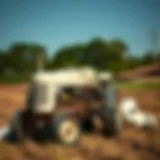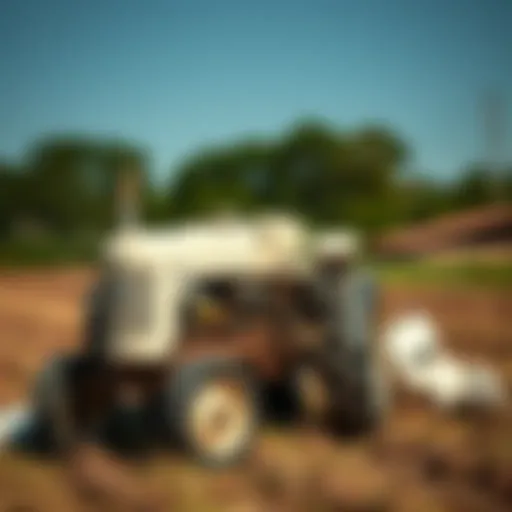The Role of Rubber Syringes in Modern Agriculture
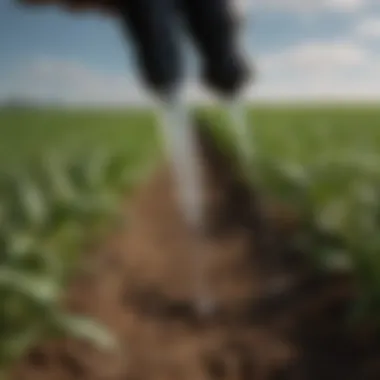

Intro
Rubber syringes are often overlooked tools in the realms of agriculture and horticulture. Yet, their significance stretches far beyond mere novelty or niche use. These adaptable devices serve a plethora of purposes, making them vital for both novice gardeners and seasoned agronomists alike. With their versatile applications, from administering precise measurements of liquid fertilizers to effectively managing pest control, the utility of rubber syringes is extensive.
The role these syringes play is pivotal. They're not just a one-size-fits-all solution but rather, they are integral in fine-tuning practices that promote healthier plants and more bountiful yields. Their ergonomic design also aligns with sustainable practices, catering to the growing need for environmentally friendly agricultural tools. One can hardly underestimate their contribution to more effective farming strategies.
As we move through this article, we’ll dissect various aspects surrounding rubber syringes. We will wander through definitions and historical contexts, touch upon recent trends in technology, delve into the practical applications of these syringes, and ultimately, weave together insights that illustrate their importance in agricultural practices. Let's embark on this journey to grasp why rubber syringes deserve a spot in every farmer's toolkit.
Key Concepts and Terminology
Basic Definitions
At the heart of our discussion lies the basic understanding of what rubber syringes are. In simple terms, a rubber syringe typically consists of a cylindrical body made from flexible rubber and a plunger, designed to draw and expel liquids.
Their functionality can be summarized in a few key points:
- Liquid Extraction: Rubber syringes facilitate the extraction of liquid, maintaining accurate dosage.
- Irrigation Applications: They offer a simple means of applying fertilizers or pesticides to specific areas.
- Precision Measurement: Their graduations allow for precise measurements, ensuring that crops get exactly what they need.
Historical Context
Rubber syringes aren’t just a modern invention. A look into history reveals that similar devices have been utilized since ancient times. The early iterations, which were often constructed from animal bladders or early forms of rubber, provided farmers a method to administer liquids to crops. Over decades, advancements in materials and design have transformed these tools into the efficient devices used today.
Understanding this historical backdrop provides context for their continued evolution and relevance in today’s agricultural practices.
Recent Innovations and Trends
Technological Advancements
In recent years, rubber syringes have experienced a wave of modern enhancements. Innovations such as better grip designs and materials that resist chemical degradation have become increasingly common. This means more effective use, especially in environments where harsh substances such as herbicides or pesticides are involved.
These advancements lead to improved functionality, resulting in syringes that can withstand not just the chemicals involved but also the rigors of fieldwork. Moreover, several recent models even feature adjustable nozzles – allowing farmers to switch between different liquid flow rates easily.
Sustainable Practices
The shift toward sustainable agricultural practices is undeniable. Rubber syringes make notable contributions in this area. Their precision means that farmers can apply fertilizers and pesticides more judiciously, reducing wastage and environmental impact.
- Increased precision leads to minimal runoff, which in turn reduces contamination of local water sources.
- Using these syringes encourages a culture of care, where every drop counts rather than dealing with excess that isn’t utilized.
Adopting such practices is critical to meet today’s agricultural demands while minimizing adverse environmental effects.
Practical Applications and Techniques
Step-by-step Guides
Using a rubber syringe is straightforward, but ensuring best practices can enhance performance:
- Preparation: Clean the syringe thoroughly before use. Ensure no residues remain from previous applications.
- Fill the Syringe: Dip the nozzle into your liquid and pull back the plunger slowly to draw the desired amount.
- Application: Direct the nozzle where needed and push the plunger gently to release the liquid. Monitor flow closely to prevent over-application.
- Post-Use Cleaning: Rinse thoroughly after use to prevent cross-contamination.
Case Studies
Examining practical instances can shed light on the benefits of incorporating rubber syringes into agricultural practices. For example, a small farm in France adopted the use of rubber syringes for targeted pest management in their organic strawberry fields. The precision application of organic pesticide led to a notable reduction in pest populations without harming beneficial insects.
This aligns with modern aims of sustainability and efficiency in farming, showcasing how rubber syringes can bridge traditional practices with contemporary demands.
Rubber syringes represent a small yet mighty tool in the push towards efficient and sustainable agriculture.
In the progression of this article, we will examine further aspects and insights into selecting the right rubber syringe, factors influencing performance, and essential maintenance techniques. Let’s keep peeling back the layers and uncovering the importance of this seemingly simple tool.
Understanding Rubber Syringes
Rubber syringes are no small players in the realm of agriculture and horticulture. These tools serve a vital purpose, ensuring precision and efficiency in tasks ranging from fertilizing crops to managing soil health. The importance of rubber syringes cannot be overstated; they are pivotal in maximizing plant growth while minimizing waste. When farmers and hobbyists use them correctly, they often see enhanced results that are hard to achieve with traditional methods alone.
Historical Development of Syringes
The concept of the syringe dates back centuries, gaining traction due to its utility in medicine before finding its way into agricultural practices. Initially crafted from glass and metal, the introduction of rubber marked a turning point. Rubber syringes became particularly well-regarded in the 20th century when innovations like improved rubber compounds enhanced their resilience and usability. As agriculture began to adopt more scientific approaches, the need for exact application of liquids became paramount. Rubber syringes, being lightweight and flexible, fit the bill perfectly. Today, they have morphed into a must-have tool in many farming operations, showcasing an interesting blend of history and practicality.
Material Composition and Benefits
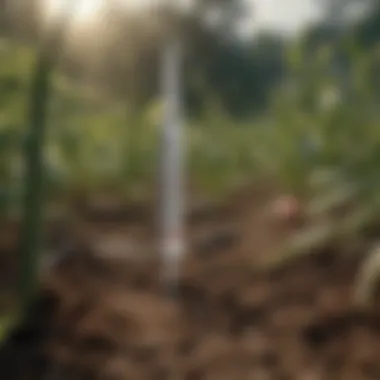

When discussing the material composition, rubber is key for several reasons. First off, rubber syringes tend to be more resilient compared to their metal or glass counterparts. They can withstand agricultural chemicals that could easily corrode other materials. Additionally, the elasticity of rubber allows for controlled dispensing. This not only means less wastage but also precise application of fertilizers or pesticides. The durability aspect can't be ignored either; many rubber syringes can last through multiple growing seasons if cared for properly.
- Chemical Resistance: Rubber can handle corrosive substances.
- Flexibility: Ease in dispensing various liquid types.
- Longevity: With good maintenance, they serve well for many years.
Design Features of Rubber Syringes
Design-wise, rubber syringes have undergone significant improvements. Their ergonomic shapes fit comfortably in hand, reducing strain during usage. The nozzle types also vary, catering to different applications—thin nozzles for intricate tasks and wider ones for faster liquid flow. Notably, many come with graduated markings, so users can easily measure out quantities, ensuring that every drop counts.
"The design is not just about aesthetics; it’s about practicality for the end-user in the field."
Some syringes even feature a plunger that can easily push through thick liquids without seizing up, which is often a common concern with lesser-quality syringes. This blend of thoughtful design and functional features has solidified the rubber syringe's role as a reliable partner in both agriculture and horticulture.
Applications in Agriculture
The use of rubber syringes in agriculture is a game changer, providing farmers and horticulturists with tools that are precise and efficient. In an era where every drop of fertilizer counts, understanding how these syringes contribute to application processes can greatly enhance both productivity and sustainability. The ability to accurately deliver the right amount of input not only maximizes yield but also minimizes environmental impact—an ever-important consideration for modern farming practices.
Precise Application of Fertilizers
When it comes to fertilizers, precision is king. Poor distribution can lead to uneven growth and wasted resources. Rubber syringes allow farmers to measure and apply liquid fertilizers with pinpoint accuracy. Picture this: a farmer wants to boost the health of a specific crop variety. Using a rubber syringe, they can dose out the exact liquid nutrient blend needed for individual plants. This targeted approach ensures that every plant receives the nourishment it requires, without excess pouring into the soil.
The benefits are multi-faceted:
- Cost Savings: Utilizing a rubber syringe minimizes waste, which translates into savings on fertilizer costs.
- Environmental Stewardship: Reducing runoff and nutrient leaching into water sources promotes a healthier ecosystem.
Pesticide and Herbicide Distribution
The distribution of pesticides and herbicides is a crucial aspect of protecting crops from pests and diseases. Rubber syringes serve as ideal tools for this purpose, particularly in small-scale applications or in areas requiring meticulous coverage.
Using a rubber syringe, farmers can also engage in integrated pest management (IPM) strategies. By applying targeted amounts of pesticides directly to affected areas, they can reduce harm to beneficial insects and promote biodiversity. In this context, it’s not just about quantity but also about quality of application. The notable advantage lies in:
- Reduced Chemical Exposure: The ability to control the dose minimizes the risk of overspray and drift, enhancing safety for both the user and surrounding flora and fauna.
- Effectiveness: With a controlled application, pests are more likely to be dealt with effectively, leading to higher overall crop health.
Irrigation Management Techniques
Equipping agriculture with the right irrigation techniques can directly influence yield and sustainability. Rubber syringes can play an essential role in this. They can deliver nutrients, water, or growth stimulants directly to the root zone of plants, optimizing water use.
In regions where water scarcity is an issue, using a rubber syringe for targeted watering ensures plants receive just what they need without waste. Proper irrigation management can be bolstered by:
- Micro-irrigation Practices: Syringes allow for the application of solutions that promote better water retention in the soil, ultimately maximizing effectiveness.
- Soil Health Monitoring: Regular application through syringes aids farmers in monitoring soil moisture levels, enhancing their ability to adapt irrigation strategies promptly.
The integration of rubber syringes in agricultural practices leads to better resource management and enhanced crop quality. Moreover, as farmers continue to seek more efficient, sustainable practices, these syringes provide a practical solution that reflects modern agricultural needs.
"Using rubber syringes not only helps in precise applications but also supports sustainable farming—balancing productivity with care for the environment."
Role in Horticulture
In horticulture, the use of rubber syringes serves as a crucial tool for various tasks, enhancing gardening techniques and achieving better outcomes. Understanding their role can streamline several processes from propagation to nutrient application, making it easier for gardeners to manage their plants effectively. These syringes shine in several specific tasks, providing accuracy, convenience, and efficiency.
Propagation of Plants
When it comes to plant propagation, precision is key. Rubber syringes allow for the meticulous application of growth hormones and rooting solutions. These solutions can stimulate root development, which is particularly vital when dealing with delicate cuttings. By using a syringe, gardeners can target just the base of the cutting without oversaturating the surrounding soil. This level of control minimizes the risk of rot, which can derail even the best gardening efforts.
For example, when attempting to propagate lavender, using a rubber syringe to apply a rooting hormone directly can significantly increase the success rate of growing new plants. This technique spares excess hormone from contaminating the entire potting area, promoting a healthier environment for both the parent plant and the new roots.
Soil Amendments and Nutrient Delivery
Rubber syringes lend a helping hand in soil amendments and nutrient delivery as well. Applying fertilizers can sometimes feel like tossing a coin in the air, hoping it lands in the right spot. With a syringe, the distribution becomes deliberate. Syringes make it straightforward to deliver water-soluble fertilizers directly to the plant's root zone.
- Let’s illustrate this with a few benefits:
- Targeted Application: It allows direct delivery without wasting resources.
- Quick Adjustment: If a plant shows signs of nutrient deficiency, a quick dose via syringe can rectify the issue almost instantly.
- Hydration Aid: Additionally, syringes can aid in introducing moisture directly to dehydrated areas of the soil.
Using a rubber syringe in this way transforms haphazard fertilizing into an art form, allowing for grown plants that are truly thriving.
Integration in Organic Gardening
The growing trend toward organic gardening means that the applications of rubber syringes are becoming even more valuable. Organic fertilizers usually have specific application methods and dilute concentrations to consider. Here, precision matters deeply in ensuring that plants receive adequate nutrition without overstimulating growth.
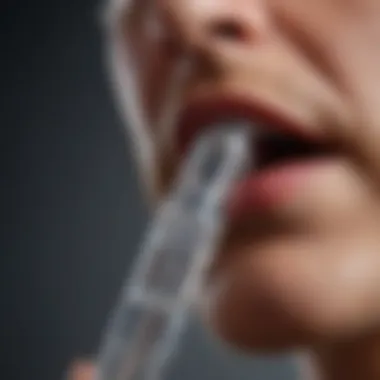

Moreover, for those involved in organic pest management, rubber syringes are a lifesaver. They help deliver organic pest deterrents not broadly but directly to the insects or affected areas. This minimizes non-target exposure, which aligns perfectly with organic gardening principles.
Advantages of Using Rubber Syringes
Rubber syringes have carved out a significant niche in both agriculture and horticulture due to their unique advantages. Understanding their benefits offers insights into why they are preferred tools among farmers and gardeners. Below, I’ll delve into the specific attributes that make rubber syringes invaluable in these fields.
Cost-Effectiveness
Rubber syringes are often more affordable compared to other types of application devices. Their simplicity in design and material composition contribute to lower manufacturing costs. Farmers typically operate on tight budgets; thus, utilizing equipment that doesn’t break the bank is crucial.
Moreover, they are designed for repeated use, allowing growers to maximize their investment. Unlike single-use plastic syringes, rubber syringes can withstand multiple applications, which means less wastage and more savings in the long run.
Durability and Reliability
One of the standout features of rubber syringes is their durability. Crafted from robust materials, they are less prone to breakage compared to their glass or plastic counterparts. Farmers working in rugged conditions need tools that can stand the test of time, and rubber syringes fit the bill perfectly.
Their reliability stems from the ability to handle various chemicals without degrading easily. Even when used with potent fertilizers or pesticides, rubber syringes maintain their integrity, ensuring consistent performance across different applications.
Versatility Across Different Settings
Rubber syringes shine in their versatility, effortlessly transitioning between multiple agricultural tasks. They can be used for watering seedlings, applying nutrients, or distributing pesticides in gardens and greenhouses.
- For instance, in an organic farm, these syringes facilitate precise liquid fertilizer applications without over-saturation.
- In horticulture, they are invaluable for delicate tasks like propagating plants or administering treatments to specific plants without affecting the surrounding environment.
This adaptability makes them suitable not only for large agricultural enterprises but also for small-scale gardeners.
"Rubber syringes are like the Swiss Army knife of agricultural tools; you find new uses for them every day."
Their ability to cater to various settings while fulfilling diverse roles contributes significantly to their popularity within the agricultural community.
Overall, the cost-effectiveness, durability, and versatility of rubber syringes lay a solid groundwork for their widespread use in agriculture and horticulture, establishing them as essential tools for successful farming and gardening practices.
Possible Limitations
While rubber syringes can be the unsung heroes of agriculture and horticulture, it is vital to recognize their limitations. Acknowledging these drawbacks allows users to make informed decisions on when and how to effectively utilize these tools in their practices.
Potential for Material Degradation
Rubber syringes, like any product made of specific materials, are not immune to wear and tear. Over time, exposure to environmental factors such as sunlight, moisture, and drastic temperature changes can lead to material degradation. This deterioration might manifest as cracks, loss of flexibility, or changes in the chemical properties of the rubber itself. Such degradation can undermine the effectiveness of the syringe, potentially leading to inaccurate measurements or inefficient delivery of substances. In high-stakes applications involving fertilizers or pesticides, this could mean the difference between a flourishing crop and a crop in distress.
Periodic checks are a smart practice; inspecting for any signs of wear should be part of a regular maintenance routine. As the saying goes, "a stitch in time saves nine"; addressing minor issues before they escalate into bigger problems can save time and resources in the long run.
Limitations in Large Scale Applications
In settings where large volumes of liquids need to be administered, like expansive farmland or vast horticultural establishments, rubber syringes can fall short. Their design typically favors precision over volume, meaning they may not be the most efficient tool for bulk application duties. For example, while a rubber syringe can provide exact measurements for a few plants, outfitting hundreds or thousands of plants with the same device can be tedious and time-consuming.
Many farmers or horticulturists might find that switching to larger application methods (such as sprayers or drip systems) yields quicker results without sacrificing the level of accuracy. Rubber syringes excel in tasks that require careful dosing but are often less practical in scenarios demanding high throughput.
User Error and Inaccuracies
The human element can introduce frailties into the use of rubber syringes. Simple user errors, such as not fully expelling air from the syringe before measurement or misjudging liquid quantities, can lead to significant inaccuracies. For instance, if a user miscalculates the amount of fertilizer needed and administers too much or too little, it can adversely affect plant health and growth.
Moreover, proper technique often requires training and experience. Not every user will have immediate proficiency, which could lead to inconsistent results, especially among less seasoned users. Therefore, it’s crucial to invest time in learning the correct usage of these tools to minimize errors. Just like any skill, practice and awareness improve accuracy over time.
"A craftsman is only as good as his tools, but his proficiency is what crafts the masterpieces."
Understanding the limitations of rubber syringes can equip users to adapt their methods and expectations, enhancing their effectiveness in agricultural and horticultural tasks.
Selection Criteria for Rubber Syringes
When it comes to choosing rubber syringes for agricultural and horticultural purposes, having a clear understanding of selection criteria is paramount. This criteria dictates not just performance but also efficiency in tasks that can often make or break a yield. Think of it as laying the groundwork for success in various applications—be it fertilizing crops, applying pesticides, or managing irrigation. The right selection can save both time and resources, while the wrong one can lead to waste and frustration.
Volume Capacity Considerations
Volume capacity plays a crucial role when selecting a rubber syringe. The capabilities of the syringe need to match the tasks you’ll be tackling. For example, a typical garden situation might require smaller syringes of around 10 ml, while larger farm operations might necessitate a syringe that can hold over 100 ml. It’s generally prudent to have several sizes on hand to ensure you can handle diverse applications without unnecessary refills.
In essence, thinking ahead about the amount of liquid you typically work with can elevate efficiency. If you're frequently dealing with larger volumes of fertilizer, opting for those with higher capacity is a wise move. It not only reduces the risk of spilling but also minimizes the number of trips back to your supply.
Choosing the Right Nozzle Type
Nozzle types influence the emission of liquid from rubber syringes, affecting everything from precision to flow control. Depending on the task, certain nozzle types can work wonders. For instance, a fine-point nozzle is ideal for targeted applications, such as delivering nutrients directly to the root zone, while a broader nozzle may be better suited for irrigation or distributing larger volumes of pesticide.
Understanding the relationship between nozzle types and specific tasks is vital. A misaligned choice can lead to uneven application—an error that might mean some plants are left underfed or over-saturated. Furthermore, compatibility with your syringe body should not be overlooked. Ensure that your nozzle fits well and can be easily attached or detached. This adds another layer of convenience, allowing for quick changes based on what you're focusing on that day.
Assessing Quality and Brand Reliability
When it comes to rubber syringes, quality is nothing to take lightly. Not all syringes are created equal, so choosing a brand with a solid reputation can pay dividends in the long run. Consider factors such as the durability of materials, ease of use, and warranty options. A syringe that withstands repeated use will ultimately save you money and headaches.


Look for reviews from other users—farmers and horticulturists alike share invaluable insights on platforms like Reddit or dedicated farming forums. These reviews can give you a realistic glimpse into how well a product performs under everyday farming conditions. Brands with a history of reliability tend to stand the test of time, offering support and replacement parts as needed, which is crucial in maintaining workflow.
"A well-chosen tool sets the pace for progress in agriculture and horticulture."
The selection criteria for rubber syringes are not just trivial details; they're essential elements to consider if you wish to enhance the efficacy of your agricultural practices. Each of these factors intertwines with others, creating a fabric that contributes to overall productivity.
Maintenance Tips and Best Practices
Proper maintenance of rubber syringes is crucial for ensuring their longevity and effectiveness in agricultural and horticultural tasks. As farmers and gardening enthusiasts know, the integrity of the tools we use can significantly impact the health of plants and the efficiency of operations. Neglecting maintenance can lead to issues such as contamination, incorrect dosage delivery, and eventual equipment failure. This section outlines essential practices that can help keep rubber syringes in peak condition.
Cleaning and Sterilization Procedures
The importance of thorough cleaning and sterilization cannot be overstated. With fertilizers, pesticides, and other solutions being used, residues can build up, leading to contamination or chemical reactions that might compromise future applications. Following a diligent cleaning routine ensures that syringes deliver only the intended substances, minimizing the risk to crops.
- Immediate Rinsing: After each use, empty the syringe and rinse it immediately with clean water. This step prevents substances from drying and hardening inside.
- Use Gentle Detergents: For deeper cleaning, use a mild dish soap mixed with warm water. Avoid abrasive brushes as they can scratch the rubber material.
- Sterilization: To further ensure safety, immersion in a disinfectant solution, such as diluted bleach, can help eliminate pathogens. After soaking, rinse thoroughly to remove any chemical residues.
Storage Recommendations
How you store rubber syringes can impact their lifespan significantly. Proper storage conditions can prevent degradation of the material, ensuring that the equipment remains effective issue-free. Here are some key points to consider:
- Cool and Dry Environment: Store syringes in a cool, dry place away from direct sunlight. Exposure to heat or UV light can lead to rubber deterioration over time.
- Protection from Contamination: Keep them in a clean, dust-free container. If possible, use individual compartments to prevent contact with other tools that may carry contaminants.
- Avoid Extreme Conditions: Rubber syringes should not be subjected to extreme temperatures or excessive humidity, which can warp the material and affect functionality.
Periodic Inspections for Wear and Tear
Routine checks for wear and tear should be part of your maintenance schedule. Regular inspections can catch potential issues before they become major problems, thus extending the life of the syringe. Here’s what to keep an eye out for:
- Cracks and Tears: Examine the rubber for any visible damage. Small cracks can expand and lead to leaks and inaccuracies in dispensing.
- Proper Functionality: Test the plunger mechanism to ensure it moves smoothly without excessive force. A stuck or difficult plunger may indicate an internal issue that requires attention.
- Check Seals: Inspect any seals and connections (if applicable) for signs of looseness or damage, which might impair suction or delivery precision.
Keeping rubber syringes well-maintained not only enhances their performance but also protects your investments in agricultural inputs. Investing time in these practices pays off by ensuring efficient and effective plant care.
By adhering to these maintenance tips and best practices, farmers and horticulture enthusiasts can rely on their rubber syringes to perform optimally, safeguarding plants and enhancing crop yields.
Future Developments in Syringe Technology
The needle of innovation in technology does not end with what is already available for rubber syringes. The field is ripe for advancements that can significantly enhance their efficacy and usability in agricultural and horticultural applications. As practices evolve and the demands of farmers become more nuanced, it’s essential to explore new horizons in syringe technology that can cater to these changing needs.
Innovations in Materials Science
When we talk about innovations in materials science, we refer to the use of better quality rubber or entirely new materials that offer superior performance. For example, research is underway to develop synthetic rubbers that provide greater flexibility and resistance to the degrading effects of chemicals commonly used in agriculture, like fertilizers and pesticides. This could lead to syringes that last longer and maintain their integrity much better than traditional rubber.
New coatings that reduce friction might also be introduced, making the syringes easier to operate. Such advancements could mean easier handling, especially during high-stakes applications where precision is paramount.
Moreover, some companies are experimenting with biodegradable materials that can rival traditional rubber. Using such materials not only meets the needs for performance but also caters to the growing demand for environmental sustainability in agriculture.
Integration of Smart Technology
In today's tech-savvy world, integrating smart technology into devices is becoming the norm rather than the exception. Rubber syringes are not left out of this trend. Imagine a rubber syringe equipped with sensors that can measure the exact amount of liquid being dispensed in real-time. These syringes can then connect to a smartphone app that stores the measurements and suggests optimal dosages based on specific crops or types of soil.
This could be a game changer in fertilizer application, ensuring that neither under- nor overdosing occurs, which can lead to wasted resources and potential harm to the plants. Data analytics could also provide insights into how effective certain applications are over time, enabling farmers to refine their approaches.
Environmentally Sustainable Options
As more farmers are leaning towards sustainable practices, the demand is rising for rubber syringes that align with environmentally friendly principles. This can come in various forms: from using recycled materials in the production to creating syringes that use minimal plastic components. Companies may invest in research to produce syringes that can easily break down in compost environments without leaving harmful residues.
Furthermore, incorporating renewable resources, like plant-based materials, can contribute to developing syringes that boast both performance and sustainability. Such initiatives are not just good press but resonate with a growing consumer base that values environmentally conscious practices.
"Innovative approaches to the design and materials used in rubber syringes are crucial for embracing sustainable farming and meeting the current needs of agricultural practices."
Closure
Summary of Rubber Syringe Applications
In summarizing the applications, it's clear that rubber syringes serve a broad range of functions. Whether it's distributing fertilizers with accuracy, facilitating the careful application of pesticides, or managing irrigation systems efficiently, these syringes prove to be invaluable. The ability to measure and apply liquids precisely means less waste, better targeting, and ultimately, healthier crops. This precision in application can save farmers both time and costs, indicating just how crucial they are in effective farming practices.
The Importance of Proper Usage
However, the effectiveness of rubber syringes is only as good as their usage. Educating users on how to handle these syringes appropriately ensures that the intended benefits are realized. Misuse can lead to a waste of resources or even harm to the crops and surrounding environment. Proper techniques in filling, storing, and applying can greatly enhance the syringes' efficiency and effectiveness in the field. Thus, knowledge and training are crucial.
Encouragement for Further Exploration
Finally, there is a need for further exploration into the advancements surrounding rubber syringes. As technology evolves, so do the tools that farmers can use. Innovations in material science and smart technology promise to improve the functionality and sustainability of rubber syringes. This exploration sees an industry ripe for discovery, from eco-friendly options to high-tech solutions that could revolutionize agricultural practices. Enthusiasts and professionals alike are encouraged to stay updated and engage with evolving techniques and technologies.
"To improve is to change; to be perfect is to change often." - Winston Churchill














